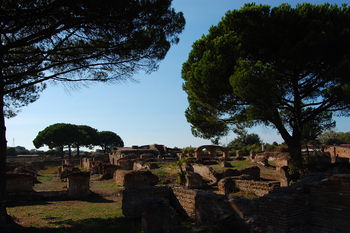Ostia: Difference between revisions
Jump to navigation
Jump to search

imported>Richard Nevell (Add image) |
imported>Richard Nevell (The harbour) |
||
| Line 4: | Line 4: | ||
'''Ostia''' was founded in 338 B.C. and acted as the port of [[Rome]]. Though the settlement flourished in the 1st century, it gradually lost importance as other ports were foudned to serve the capital of the [[Roman Empire]], and by the 4th century Ostia was in a state of decay.<ref>Hermansen, Gustav (1981). ''Ostia: Aspects of Roman City Life''. University of Alberta. pp 2, 12. ISBN 9780888640727.</ref> | '''Ostia''' was founded in 338 B.C. and acted as the port of [[Rome]]. Though the settlement flourished in the 1st century, it gradually lost importance as other ports were foudned to serve the capital of the [[Roman Empire]], and by the 4th century Ostia was in a state of decay.<ref>Hermansen, Gustav (1981). ''Ostia: Aspects of Roman City Life''. University of Alberta. pp 2, 12. ISBN 9780888640727.</ref> | ||
A monumental statue stood at the mouth of Ostia's harbour, emulating a fashion for such displays in the ancient world, as established by the [[Colossus of Rhodes]].<ref>Higgins, Reynold (1988). “The Colossus of Rhodes” in Peter A. Clayton and Martin J. Price (eds.) ''The Seven Wonders of the Ancient World''. London: Routledge. p. 134. ISBN 0-415-05036-7.</ref> | |||
==References== | ==References== | ||
{{reflist}} | {{reflist}} | ||
Revision as of 04:27, 26 August 2013
Ostia was founded in 338 B.C. and acted as the port of Rome. Though the settlement flourished in the 1st century, it gradually lost importance as other ports were foudned to serve the capital of the Roman Empire, and by the 4th century Ostia was in a state of decay.[1]
A monumental statue stood at the mouth of Ostia's harbour, emulating a fashion for such displays in the ancient world, as established by the Colossus of Rhodes.[2]
References
- ↑ Hermansen, Gustav (1981). Ostia: Aspects of Roman City Life. University of Alberta. pp 2, 12. ISBN 9780888640727.
- ↑ Higgins, Reynold (1988). “The Colossus of Rhodes” in Peter A. Clayton and Martin J. Price (eds.) The Seven Wonders of the Ancient World. London: Routledge. p. 134. ISBN 0-415-05036-7.
